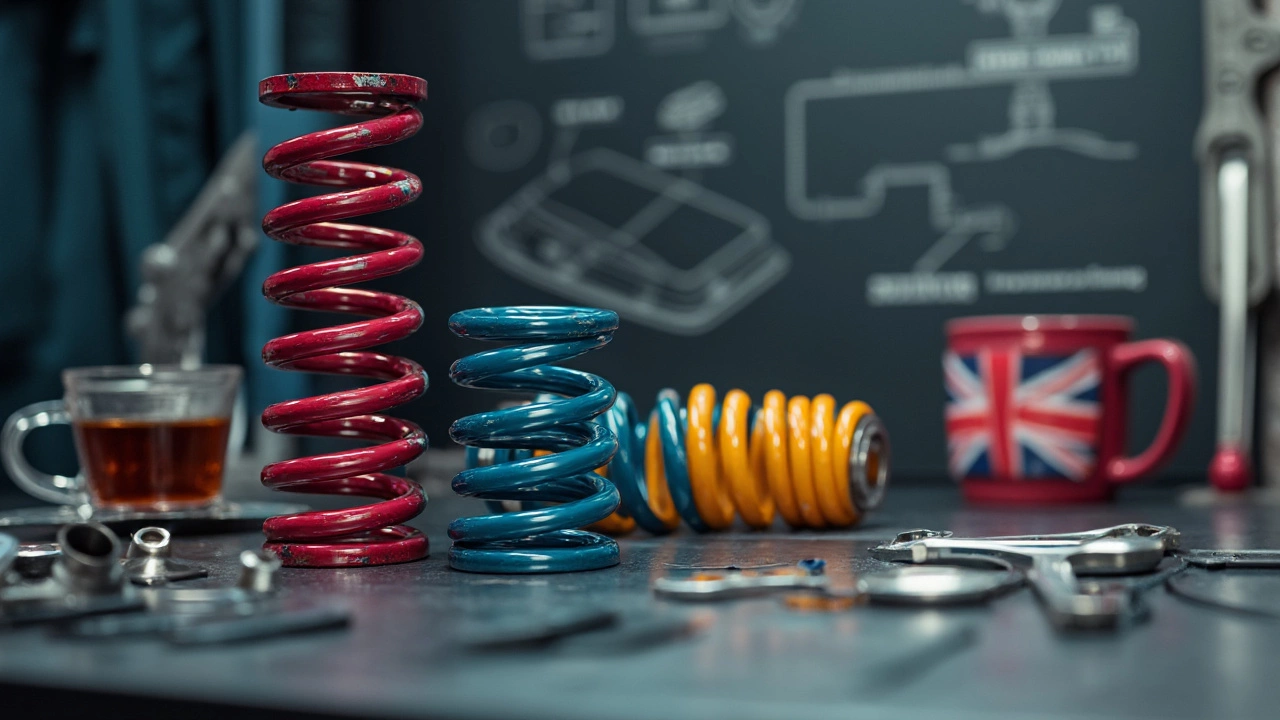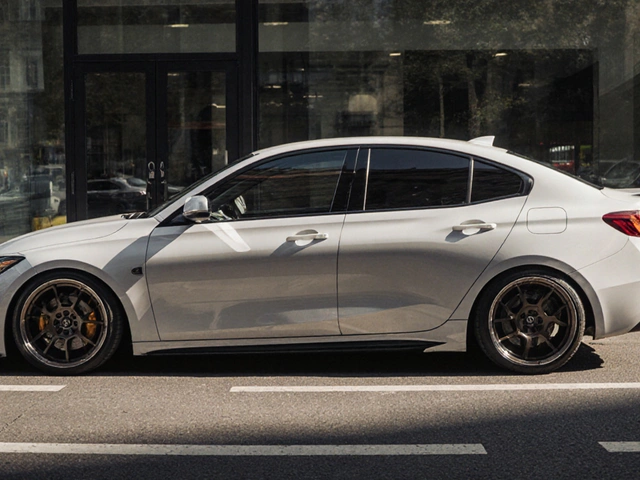Ever looked at a slammed car and wondered if you could get the same look by just swapping out the factory springs for some lowering ones? It's a common question, especially when you're trying to keep it cheap but still want your ride lower to the ground and looking sharper. The simple answer: yes, you can lower your car with just springs, but there’s way more to it than just popping out the old coils and tossing in new ones.
Lowering springs are designed to be shorter and stiffer than your stock springs, so when you install them, your car will instantly sit closer to the pavement. This gives you a sportier stance and can even improve handling in some cases—less roll when you’re cornering and a more direct feel on the road. Sounds good so far, right?
But here’s where it gets interesting: just throwing in lowering springs isn’t always a “one and done” mod. Your car’s shocks and struts are made for the original springs, not the shorter lowering ones. If you only change the springs, you could end up with a bouncy or even harsh ride. Plus, you might wear out your shocks way faster than normal. That’s just scratching the surface—there’s stuff like alignment, tire wear, and clearance issues you’ve got to pay attention to.
So before you get under your car with a wrench, stick around. I’ll walk you through what really happens when you lower a car with just springs and what smart steps you should take. A drop that’s cheap now could cost you more in the long run if you don’t do it the right way.
- How Lowering Springs Actually Work
- What Happens If You Only Replace Springs
- Risks and Problems You Might Face
- Smart Tips Before You Lower
How Lowering Springs Actually Work
So what’s really happening when you bolt on a set of lowering springs? The main idea is simple: these springs are physically shorter than your factory ones, and usually have a higher spring rate. Meaning, they’re stiffer and harder to compress. When you drop them in, your car’s ride height goes down and the suspension becomes a bit tighter.
Here’s why people go for lowering springs—when you lower a car, you’re bringing down the center of gravity. That actually makes a difference, especially in corners. A lower ride usually means less body roll when you turn, and you’ll often feel more connected to the road. It’s not just about the look (even though that’s a big reason for most). Lowering can help you get a sharper, sportier feel—if you do it right.
Lowering springs are usually made from high-strength steel. They’re wound to different specs than your stock ones. The tighter wind and specific materials help them handle the job of being stiffer without snapping under pressure. Most big brands, like Eibach or H&R, test their springs to fit certain makes and models, so you’re not just guessing if they’ll work.
There’s no hacks involved—just swapping the springs uses your stock shocks and struts. It’s a straight-up replacement. But it’s important to remember: those factory shocks were designed for much softer, taller springs. If you want everything to last and work smoothly, it’s smart to check whether your shocks are up for the job or if you want to pair the lowering springs with performance shocks down the line.
- Lowering springs reduce fender gap (that weird space between tire and wheel arch).
- They’re measured in inches or millimeters for drop—common ranges are 1 to 2 inches.
- Better cornering is real, but too much drop can cause problems like bottoming out or rubbing tires.
- If you ever see a car with that mean, tucked-in tire look, most likely, lowering springs or coilovers made that happen.
At the end of the day, if you want that clean, lower look and a hint of sportiness, lowering springs are the go-to mod. They’re simple, cheaper than full kits, and get the job done—just know what you’re working with before reaching for your toolbox.
What Happens If You Only Replace Springs
So you’re thinking about grabbing some lowering springs, swapping them in, and calling it done. That’s what a ton of people do on a budget, but it isn’t all smooth sailing. When you only replace the springs and leave your shocks and struts stock, there are some noticeable changes in how your car feels and handles.
First off, your ride height drops—and yes, that’s the goal. Most lowering springs cut anywhere from 1 to 2 inches off your stock height. Your car hugs the ground closer, which looks great and can lower your center of gravity.
But here’s what auto repair shops see all the time: stock shocks weren’t made for shorter, stiffer springs. Because of that mismatch, you might get a bouncier, rougher ride. Sometimes, you’ll hear knocking noises over bumps, or it’ll feel like your car skips when you hit uneven pavement. The extra wear from the stiffer springs can wear out original shocks up to 2-3 times quicker. According to a 2022 suspension survey by an aftermarket parts retailer, they found that over 65% of DIYers who used only lower springs reported shock failure or “dead” shocks within 20,000 miles.
The impact isn’t just comfort or ride quality—other stuff gets affected, like tire wear, alignment, and braking.
- Tire wear: If you don’t get an alignment after lowering, your tires could wear out on the inner or outer edges way faster than normal.
- Alignment: Even a subtle drop can throw off your camber and toe settings. Misalignment means annoying handling and, again, more tire wear.
- Braking: Lowering can sometimes improve stopping but only if the rest of the suspension is set up to match. If not, you might get squirmy stops or more nose dive.
Check out some common differences between factory and aftermarket springs in this table:
| Spring Type | Ride Height Change | Ride Quality | Shock Longevity |
|---|---|---|---|
| Factory Springs | Standard | Comfortable | 60,000-100,000 mi |
| Lowering Springs Only | Lowered 1-2" | Stiffer, Harsher | 15,000-40,000 mi* |
*Mileage depends on quality of both the springs and original shocks.
Going with just springs keeps costs down, but it does mean you’re rolling the dice on comfort, performance, and how long other parts last. If you’re using your car every day or care about how it drives, it’s something to think hard about before you wrench away in the driveway.

Risks and Problems You Might Face
Installing lowering springs seems like an easy upgrade, but there are some real downsides you’ll want to think about before committing. The biggest issue pops up when you only change the springs and leave your original shocks and struts. Stock shocks are set up for a certain spring length and rate. Put in short, stiff springs, and suddenly your shocks are working outside their design. That means you could end up with a dodgy ride and worn-out parts way faster than you planned.
- Lowering springs can lead to a bouncy or super stiff ride if your shocks can’t keep up. You might feel every crack, pothole, or speed bump like never before.
- You’re also messing with your suspension geometry. Just dropping the car changes the angle of your wheels (especially camber and toe). This often leads to uneven tire wear or lousy grip in wet weather. Unless you get a proper alignment after installing, you’ll probably burn through tires faster.
- Ever heard that scraping sound when someone goes over a driveway? That’s real. Lowering a car means you’ll have less ground clearance. Expect to scrape on steep driveways, speed bumps, or even regular roads if you’re not careful. You also have to watch out for rubbing, where tires start hitting the inner fender or suspension parts over big bumps or full turns.
There’s one more thing most people miss: your car’s handling might not always get better. If you go too low just with springs, your suspension travel shrinks, which means less cushion from the shocks. Sometimes, that can make handling worse or even unsafe if the wheels lose contact with the road. And if you’ve got a daily driver, that can mean a lot more headaches (and repair bills).
The bottom line? If you want your car to look and handle right, just swapping springs isn’t always the whole answer. You’ve got to look at the full picture—your shocks, alignment, tires, and even daily driving habits—before you grab a set of lowering springs from the shelf.
Smart Tips Before You Lower
Thinking about swapping out your factory springs? Slow down for a sec—if you just slap on lowering springs, there’s a real risk of messing up your ride or making it drive like a shopping cart. Here’s how you can play it smart and avoid headaches.
- Lowering springs can cut anywhere from 1 to 2.5 inches off your ride height, depending on the brand and your vehicle. Don’t go for the lowest drop if you daily drive over speed bumps or roughed-up city roads. Aim for a drop in the middle of the range if you want that look without scraping your bumper off.
- Always check if your new springs play nice with your existing shocks and struts. Many brands recommend pairing their springs with upgraded shocks. It’s not really about selling you more stuff—factory shocks just aren’t made for the tighter travel range. Mismatched parts mean blown shocks in as little as 15,000 miles in some cases.
- Don’t forget about your car’s alignment. Dropping the car changes your suspension geometry. Get a fresh alignment as soon as the springs settle (usually about a week after install). This keeps your tires from wearing unevenly or losing grip in wet or aggressive driving.
- Ride comfort is a biggie. Lower means stiffer, and if you already hate potholes, you might get a rude awakening. Lowering springs range from “firm” to “track-only” stiff. Read reviews from drivers with your same car, and stick with a street-friendly spring rate unless you track your car every weekend.
- Look at the full install cost. Besides the springs themselves, budget for labor if you’re not DIY-ing, plus the price of an alignment and possibly new shocks. It’s not rare to shell out $500+ for everything, even when doing the basics.
Check out this quick comparison table so you know what you’re getting into based on some popular lowering spring options:
| Brand | Drop (Front/Rear) | Recommended Application | Price Range (USD) |
|---|---|---|---|
| Eibach Pro-Kit | 1.0" / 1.0" | Daily/Street | $250-300 |
| H&R Sport | 1.5" / 1.3" | Sporty Street | $220-270 |
| Tein S.Tech | 1.5" / 1.3" | Entry-Level/Mild Track | $180-250 |
| Swift Spec-R | 1.0" / 1.0" | Performance Street | $350-400 |
Finally, check your ground clearance at home before you make the jump. Measure the lowest point on your car and subtract the expected drop. You don’t want to bottom out after a simple driveway dip, especially if you live somewhere with curbs that act like mountains. Do your homework, plan your budget, and double-check compatibility, and you’ll actually enjoy rolling lower instead of regretting it.




